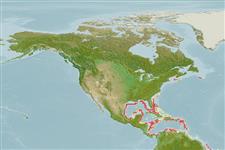Mixini (Missine) (hagfishes) >
Myxiniformes (Hagfishes) >
Myxinidae (Hagfishes) > Eptatretinae
Etymology: Eptatretus: hepta (Gr.), seven; tretos (Gr.), perforated (i.e., with holes), referring to seven gill apertures on what would later be described as Homea banksii (=E. cirrhatus) [range within genus is 6-14 pairs of gill apertures] (See ETYFish); minor: Latin for less, referring to small size of mature specimens when compared with E. springeri (See ETYFish).
More on authors: Fernholm & Hubbs.
Environment: milieu / climate zone / depth range / distribution range
Ecologia
marino batidemersale; non migratori; distribuzione batimetrica 300 - 400 m (Ref. 31276). Deep-water
Western Central Atlantic: Gulf of Mexico.
Size / Peso / Age
Maturity: Lm ? range ? - ? cm
Max length : 39.5 cm TL maschio/sesso non determinato; (Ref. 31276)
Short description
Chiavi di identificazione | Morfologia | Morfometria
Gill apertures 6 (rarely 5). Slime pores: prebranchial 15-18; branchial 4-6; trunk 41-48; tail 11-14; total 74-82 (Ref. 41105). With a thin whitish middorsal stripe; total cusps 46-54 (Ref. 36999).
Life cycle and mating behavior
Maturità | Riproduzione | Deposizione | Uova | Fecundity | Larve
Copulatory organ absent. The gonads of hagfishes are situated in the peritoneal cavity. The ovary is found in the anterior portion of the gonad, and the testis is found in the posterior part. The animal becomes female if the cranial part of the gonad develops or male if the caudal part undergoes differentiation. If none develops, then the animal becomes sterile. If both anterior and posterior parts develop, then the animal becomes a functional hermaphrodite. However, hermaphroditism being characterised as functional needs to be validated by more reproduction studies (Ref. 51361 ).
Fernholm, B., 1998. Hagfish systematics. p. 33-44. In J.M. Jørgensen, J.P. Lomholt, R.E. Weber and H. Malte (eds.) The biology of hagfishes. Chapman & Hall, London. 578 p. (Ref. 31276)
IUCN Red List Status (Ref. 130435: Version 2024-1)
Threat to humans
Harmless
Human uses
Pesca: di nessun interesse
Strumenti
Special reports
Download XML
Fonti Internet
